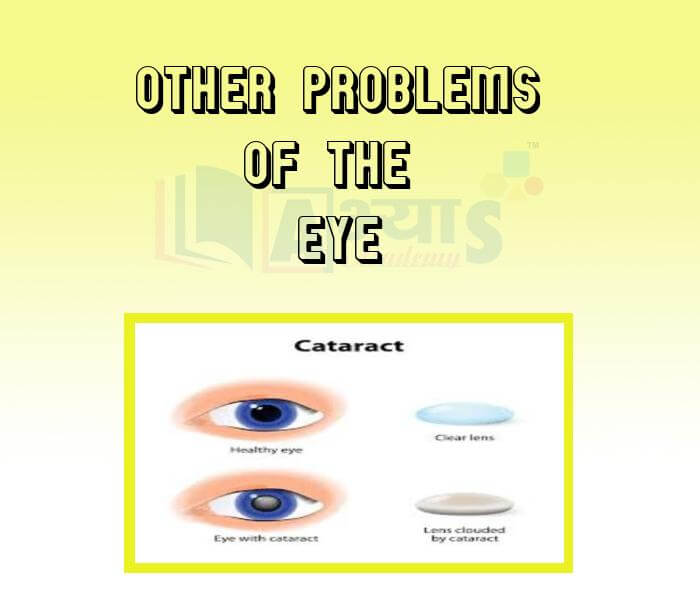Other problems of the Eye













Other Problems of the Eye
Other Problems of the Eye: Apart from the common defects described above, a person may develop other problems that hinder clear vision.
For example, looking at the sun with naked eyes during a solar eclipse can damage the retina.
Cataract: A common problem in old age is cataract, which gradually reduces the amount of light reaching the retina. The crystalline lens of the eye is made of proteins that are arranged in a regular pattern, which makes the lens transparent. When a group of these protein molecules get lumped in a region, it becomes opaque, and we say that a cataract has developed in the region. Gradually the cataract grows, and finally, the whole lens becomes opaque. And as the cataract grows, the ability of the person to see diminishes. To restore vision, the affected lens is surgically removed, and an artificial lens is placed in its place.
Astigmatism : Astigmatism is the most common refractive problem responsible for blurry vision. Anything other than the perfectly round contributes to abnormal connect. When the cornea is oblong shaped, it causes light rays to focus on two different points on the retina, instead of just one.Astigmatism can start in childhood or in adulthood.This defect can be corrected by using cylindrical lens.
Night Blindness. Deficiency of vitamin A contributes to blindness by making the cornea very dry, thus damaging the retina and cornea. Night blindness is the inability to see well at night or in poor light such as in a restaurant or movie theater. It is often associated with an inability to quickly adapt from a well-illuminated to a poorly illuminated environment.
Astigmatism can be corrected by using __________________. | |||
| Right Option : C | |||
| View Explanation | |||
Astigmatism can be corrected by using _______________. | |||
| Right Option : C | |||
| View Explanation | |||
Cataract is a condition of eye when ______________. | |||
| Right Option : D | |||
| View Explanation | |||
Students / Parents Reviews [10]
About Abhyas metholodology the teachers are very nice and hardworking toward students.The Centre Head Mrs Anu Sethi is also a brilliant teacher.Abhyas has taught me how to overcome problems and has always taken my doubts and suppoeted me.

Shreya Shrivastava
8thMy experience was very good with Abhyas academy. I am studying here from 6th class and I am satisfied by its results in my life. I improved a lot here ahead of school syllabus.

Ayan Ghosh
8thMy experience with Abhyas is very good. I have learnt many things here like vedic maths and reasoning also. Teachers here first take our doubts and then there are assignments to verify our weak points.

Shivam Rana
7thMy experience with Abhyas academy is very good. I did not think that my every subject coming here will be so strong. The main thing is that the online tests had made me learn here more things.

Hiya Gupta
8thIt was good as the experience because as we had come here we had been improved in a such envirnment created here.Extra is taught which is beneficial for future.

Eshan Arora
8thI have spent a wonderful time in Abhyas academy. It has made my reasoning more apt, English more stronger and Maths an interesting subject for me. It has given me a habbit of self studying

Yatharthi Sharma
10thIt was a good experience with Abhyas Academy. I even faced problems in starting but slowly and steadily overcomed. Especially reasoning classes helped me a lot.

Cheshta
10thAbhyas is a complete education Institute. Here extreme care is taken by teacher with the help of regular exam. Extra classes also conducted by the institute, if the student is weak.

Om Umang
10thOne of the best institutes to develope a child interest in studies.Provides SST and English knowledge also unlike other institutes. Teachers are co operative and friendly online tests andPPT develope practical knowledge also.

Aman Kumar Shrivastava
10thA marvelous experience with Abhyas. I am glad to share that my ward has achieved more than enough at the Ambala ABHYAS centre. Years have passed on and more and more he has gained. May the centre flourish and develop day by day by the grace of God.
